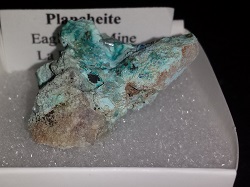A- |
B- |
C- |
D- |
E- |
F- |
G- |
H- |
I- |
J- |
K- |
L- |
M- |
N- |
O- |
P- |
Q- |
R- |
S- |
T- |
U- |
V- |
W- |
X- |
Y- |
Z |
PLANCHEITE:Plancheite is another in the long list of secondary copper minerals.And like so many of them, this one is colorful, attractive, has interesting crystal habits and is definitely a good collection mineral.Its almost turquoise-like color is unique and its typical fibrous, radial habit makes for simply a one-of-a-kind mineral. It is named for J. Planche, who first brought specimens of plancheite from the Congo region to the mineralogical community.Plancheite can be found with other colorful secondary copper minerals such as dioptase, shattuckite, conichalcite, brochantite and chrysocolla,making some specimens a treasure trove of rare minerals.
Luster is vitreous to silky.
Transparency specimens are translucent to opaque.
Crystal System is orthorhombic.
Growth Habits include spherulites or sprays of acicular or fibrous radial crystal clusters. Other habits include massive,
mammillary and fibrous aggregates and tiny tabular or platy crystals.
Cleavage is not discernible
Fracture is fibrous
Hardness is 5.5.
Specific Gravity is approximately 3.6 - 3.8 (above average for a non-metallic mineral).
Streak is pale blue.
Associated Minerals are cerussite, dioptase, limonite, melanotekite, quartz, shattuckite, bindheimite, conichalcite,
brochantite, "bisbeeite"; (a variety of chrysocolla), and other chrysocolla varieties, and other secondary copper minerals.
Notable Occurrences include the type locality of Mindouli, Congo as well as Tantara and Kambowe, Shaba, of the Democratic
Republic of Congo and several copper deposits in Arizona, especially the Table Mountain Mine.
Best Field Indicators are color, crystal habit, density, locality and associations.
|

